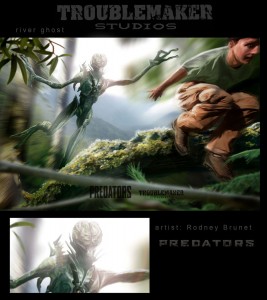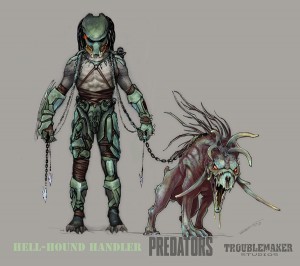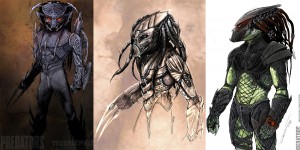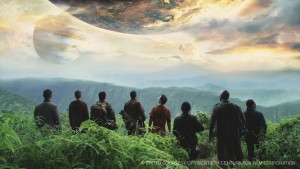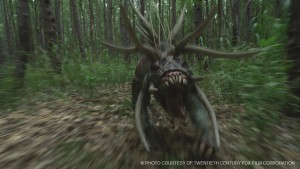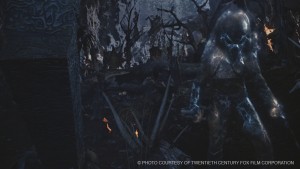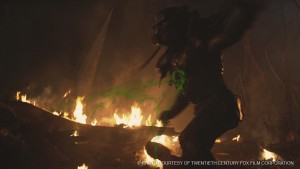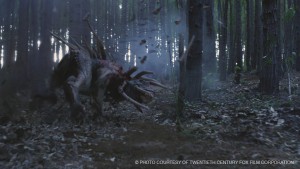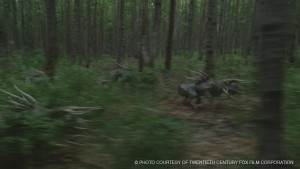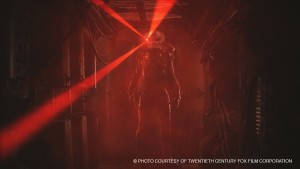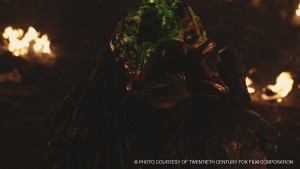For the 2010 film Predators, director Nimrod Antal and producer Robert Rodriguez set out to maintain the appeal of the 1987 original film by employing similar designs and relying on both practical and digital effects. We take a look at the visual effects work by Troublemaker Digital and Hybride.
The film, conceived as the third in the Predator franchise, follows a group of strangers who unwittingly find themselves in thick jungle on an alien planet hunted down by the now-familiar creatures. Responsible for some of the key designs and concepts was Troublemaker Digital, the special effects division of Robert Rodriguez’s Troublemaker Studios, which sought to update the franchise’s visuals for a modern audience but remain true to its original feel. “We’re all from that vintage of 80s action movies,” recalled Troublemaker visual effects supervisor Chris Olivia, “and the first Predator has a special place in our hearts.”
This was especially the case for the Predators themselves, which were constructed as practical suits by KNB EFX Group, Inc. Three main Predators – Mr Black, the Falconer and the Dog-Tracker – were conceptualised at Troublemaker. “When we first started talking to Nimrod and Robert,” noted Troublemaker’s Alex Toader, “it was clear that we wanted to do a Predator movie back to the look and feel of the original. The look of the new character that had to belong in the same Predator family but had to be more fearsome and distinct from the classic, but not going down the path of the AVP series.”
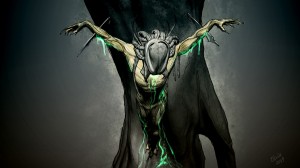
Predators opens in dramatic fashion as a number of characters are seen free-falling from the sky into a jungle terrain. “It was basically a blend of many techniques,” said Hybride visual effects producer Daniel Leduc. “In one section, they shot a real guy in the sky with a parachute so we had to erase the parachute on his back and to add a gun on every shot. Other sections involved a real guy on greenscreen with wind and everything.” Opening parachutes were achieved with CG cloth simulations and clouds rendered in CG or enhanced from the live plates.
At one point, the group face some ferocious Hounds, horned dog-like creatures released to flush out the Predator’s victims. Troublemaker embarked on a series of concept drawings which were then provided to KNB to build as a mechanical hound. Hybride received a digital scan of this animatronic, using XSI and Zbrush to construct a final model for rigging and animation. “We did a lot of run cycles,” said Hybride 3D supervisor Philippe Theroux. “The Hounds look very heavy but they also had to be swift. We had to get the right balance between big and heavy and powerful beasts but also beasts that could be swift and move rapidly through the forest.”
Production shot live action plates with the actors in a jungle setting that was LIDAR scanned. For interaction between the hounds and the ground and surrounding vegetation, Hybride created CG plants incorporated into a crude model of the jungle that matched the camera and lenses from the shoot. “We would erase the path that they shot the plates on which had dead leaves and twigs,” said Theroux. “We created new ones all in CG and we created the vegetation on the side to hide the junction between the CG bottom and the top part of the plate. That meant we could have our hounds running with dynamics and some shaders we wrote in ICE in Softimage that let us have believable plants and vegetation.”
The group is able to fend off the Hounds using their weapons, with damage added to the CG models on a shot by shot basis. “We had a bank of wounds for the Hounds,” observed Theroux. “For every shot, the animators could pick a series of wounds and everything was baked together and sent to the lighting department and to rendering. The main thing was continuity. Horns being shattered by the machine guns had to work for each cut.”
Hybride was also responsible for augmenting shots of a extra-terrestrial life-form seen running through the forest that is ultimately killed. “The group is stalking one of these guys and when they shoot it they realise it’s another type of alien,” explained Theroux. “We called this guy the Ram Runner. They had a stunt guy running through the forest in a suit and in some of the shots the director felt the motion looked too much like a human in a suit, so we had to enhance. We used 2D techniques or sometimes we replaced him with a CG character. They shoot the lifeform and we had to replace the creature on the ground with a CG one and in this sequence you see some of the roaches coming out of the body, which matched up with the cages seen earlier in the film.”
A jungle fly-over shot featuring one of the Predator’s Falcon scouts was shared between Troublemaker and Hybride, marrying three shooting locations. The shot starts at a body of water and goes up a cliff before transitioning into the jungle and then travelling with the Falcon in full view as it arrives at the Predator camp, a live action set. Other shots shared in terms of designs by the two facilities included the planet reveal, drills seen as a the group is offered refuge by a long-term survivor of the planet and the Predator’s spaceship.
Cloaking effects for the Predators, which had to match the look and feel of the original film’s effects, began at Troublemaker which did some early tests with a 3D model of a Predator and some basic refraction. The studio also took a practical approach and filmed some tests shots outside with a camera. “We climbed a tree at one point and filmed Chris Olivia running through the brush with a blue shirt on trying to see what was readable,” said Rodney Brunet. “That’s really what we do here with Robert – we help with ideas but we also try and work out techniques.
The final cloaking effects were realised as a 2 1/2 D approach by Hybride. “It was a basic 3D model for the shape to allow for the energy to move over the surface and for a background refraction,” said Daniel Leduc. “For transitions, we used clean plates and then a plate with the character in shot.” Other effects involving the Predators included the plasma blasts, sometimes involving the digital erasure of the prop gun and tracking a CG version in its place for animation and interactive lighting. The plasma blast itself was a 2D effect. Infrared Predator point of view shots were done with rotoscoping techniques based on reference from actual infrared cameras. Hybride also enhanced green blood hits on the Predators using 2D techniques or splashes in RealFlow.
One of the group members, Mombassa, meets a grisly death when he is hit with a projectile that then shoots spikes out from inside his body. The director tasked Troublemaker with coming up with animatics for the death and the final shot. “Alex Toader did the model of the spike and I textured it and modelled the fluid effects with ICE and did the animation in XSI,” said Troublemaker’s Rodney Brunet. Tracking for the shot, made complicated by the lack of a strong support for the actor was completed with pfTrack, with background reconstruction and compositing handled in Nuke.
Looking to escape the jungle, members of the group seek to hijack the Predator spaceship. Via remote control, the ship does take off before being destroyed. Troublemaker designed, modelled and textured the ship before handing off the asset to Hybride for animation. The forest seen around the ship was completed in Maya and ICE in XSI. “We made shaders that enabled us to match the look of the forest where they actually shot in Hawaii, using a LIDAR scan as a base,” said Theroux. “ICE let us populate hundreds of trees and leaves to create forests or blend with real ones.”
Hybride ultimately completed 470 shots for the film, each one having to fit into the original’s mantra, according to Philippe Theroux. “For example, the look of the cloaking effect had to feel like yesterday but look like today, and that was what we did with all the effects.”

